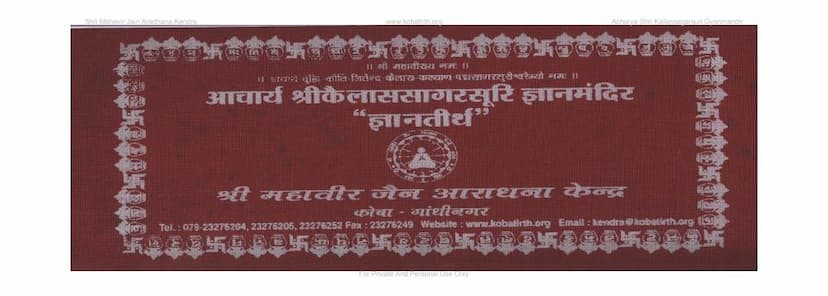Jambuswami Charitam
Added to library: September 2, 2025

Summary
Here is a comprehensive summary of the "Jambuswami Charitam" by Muni Shri Shubhankarvijay, based on the provided text:
Book Title: Jambuswami Charitam Author: Muni Shri Shubhankarvijay Publisher: Ramanlal Chhotalal Parikh Source: Derived from the "Parishisht Parva" by Shri Hemchandracharya. Theme: The life story of Jambuswami, the fifth Ganadhara (chief disciple) of Lord Mahavir, focusing on his final life.
Summary:
The "Jambuswami Charitam" narrates the life of Jambuswami, a prominent disciple of Lord Mahavir. The story begins with the affluent and devout couple Rishabdatta and Dharini in Rajagriha. They are deeply devoted to Jain principles, particularly to the Arhats and Sadhus. Despite their prosperity, they are troubled by their childlessness.
One day, Dharini expresses her sorrow to her husband, who decides to take her to Vaibhar mountain to cheer her up. During their outing, they encounter Yashomitra, a lay follower (Shravak), who is on his way to meet Sudharma Swami, the fifth Ganadhara of Lord Mahavir, who is residing in a nearby garden. Rishabdatta and Dharini accompany Yashomitra to pay their respects to Sudharma Swami.
At the garden, Yashomitra asks Sudharma Swami about the Jambu tree (after which Jambudweep is named). Sudharma Swami describes its grandeur. Dharini then asks if she will have a son. A wise disciple of Sudharma Swami predicts that she will have a son named Jambu, who will be virtuous and blessed with divine presence, after she dreams of a white lion.
Dharini soon has this dream and shares it with Rishabdatta, confirming the prophecy. She experiences various pregnancy cravings (dohada), which Rishabdatta fulfills with great devotion. After a normal gestation, Dharini gives birth to a son, whom they name Jambu, due to the dream and the auspiciousness associated with the Jambu tree. Jambu grows up to be a handsome, virtuous, and intelligent young man.
Meanwhile, the parents of eight noble families from the city approach Rishabdatta, proposing a marriage alliance between their eight daughters and Jambu. Rishabdatta readily agrees.
One day, Jambukumar hears Sudharma Swami delivering a sermon and is deeply moved by the teachings, developing a sense of detachment from worldly life. He decides to renounce the world and requests permission from his parents. His parents, though initially reluctant, agree to his marriage to the eight girls first, after which they themselves intend to renounce the world.
Jambukumara marries the eight daughters. Following the wedding, the text introduces several illustrative stories and parables told by Jambukumar to his wives and others, and by his spiritual predecessors, to impart moral and spiritual lessons. These include:
- The story of Prabhav the thief: Demonstrating the futility of worldly attachments and the power of devotion and inner purity.
- The story of Madhubindu (honey drop): Illustrating the fleeting nature of sensual pleasures and the many dangers of worldly life.
- The story of Kuberdatta: Highlighting the complexities of relationships, karmic consequences, and the importance of righteous conduct, even within a seemingly incestuous situation.
- The story of Maheshwaradatta: Exemplifying the cycle of birth and death and the consequences of actions, even in animal rebirths.
- The story of the Crow: Showing how attachment to the physical body and worldly desires can lead to destruction.
- The story of the Monkey: Illustrating the dangers of attachment to sensual pleasures and the consequences of failing to adhere to vows.
- The story of the Elder Women (Buddhi and Siddhi): Teaching the perils of greed and envy, and how excessive desire can lead to self-destruction.
- The story of the Horse (Jaindas's horse): Demonstrating the importance of righteousness, detachment from harmful influences, and the power of devotion.
- The story of the Village Outcast: Emphasizing the need for diligence and fulfilling one's responsibilities.
- The story of Solak: Illustrating the negative consequences of deceit and attachment to sensuality.
- The story of the Masahasa bird: Warning against the folly of pursuing uncertain future gains over present realities.
- The story of the Three Friends: Differentiating between superficial friendships and true spiritual companionship.
- The story of Nagashri: Showcasing the art of deception and the potential for manipulation through storytelling.
- The story of Lalitang: Depicting the devastating consequences of lust and attachment.
- The story of the Shradhak: Illustrating the dangers of uncontrolled desires and attachment to worldly pleasures.
- The story of the Peacock: Conveying the importance of virtue and the transient nature of worldly beauty.
- The story of the Elephant: Highlighting the consequences of attachment and the illusion of worldly power.
- The story of the Farmer's Son: Emphasizing the importance of proper judgment and avoiding hasty decisions.
- The story of the Drummer: Illustrating the fleeting nature of worldly pleasures and the importance of spiritual pursuits.
Jambukumara, after understanding the deeper spiritual meanings behind these stories and the teachings of Sudharma Swami, renounces the world. His friend, Prabhav, also inspired, joins him in renunciation after seeking permission from his parents. Jambukumar, along with Prabhav and others, embraces the path of asceticism under Sudharma Swami.
The narrative then shifts to Sudharma Swami's arrival in Champanagari. The citizens, including King Kūṇika, flock to see him. King Kūṇika, witnessing the devotion of the people and hearing about Sudharma Swami, is deeply impressed and resolves to visit the Ganadhara. He learns about Jambukumar's past lives and the merits that led him to his present enlightened state from Sudharma Swami. He is told that Jambukumar will attain omniscience in this very life.
The text concludes by stating that Jambuswami, after receiving instructions from Sudharma Swami and enduring many hardships, attained Kevala Jnana (omniscience) and eventually Nirvana (liberation). He lived for 60 years after Lord Mahavir's nirvana and appointed Kapiswami as his successor before departing for his final abode. The text credits Muni Shri Shubhankarvijay for compiling this account, which is an elaboration of the "Parishisht Parva" and chronicles the final life of Jambuswami.